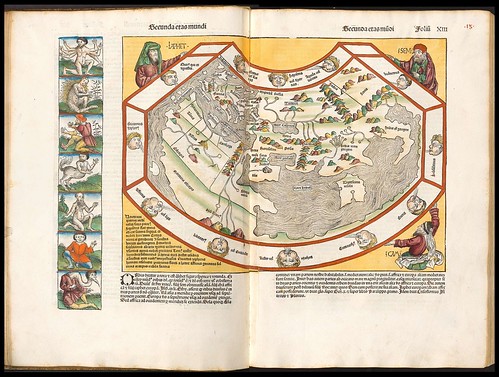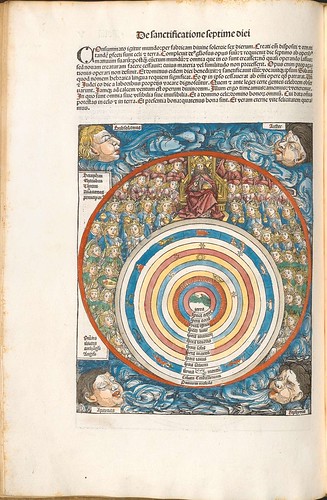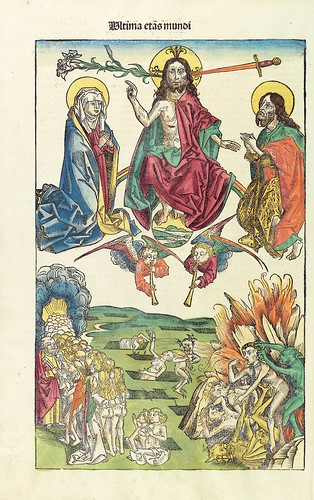The Nuremberg Chronicle

The famous world map from Hartmann Schedel's 'Nuremberg Chronicle', in the style of Ptolemy, leaves out Scandinavia, East Asia and the southern reaches of the African continent, yet includes a large island off the west African coast. The sons of Noah (Shem, Japhet and Ham: they populated the earth following the great - biblical - flood) are illustrated around the outside of the map.
The curious figures on the left include a centaur, a cyclops and various other fanciful characters and monsters, derived from early travellers' tales such as Pliny the Elder's first century AD epic, 'Natural History' and, perhaps, from the popular 'Romance of Alexander' legends. The implication being that strange creatures dwell in far away places. [zoomable b&w version]

City map of Florence

City map of Nuremberg

Germanocentric map of central Europe

The city map of Venice includes the palace of the doge (duke), St. Mark’s Basilica, the Campanile (bell tower) and other landmarks still visible today.

An imaginary view of the destruction of Jerusalem in one of the earliest maps of that city. The design is likely a collaboration between Felix Fabri, who had visited the Holy Land in 1480, and the author/woodcut artists who produced 'Liber Chronicarum' (Book of Chronicles)

Geocentric view of the universe, including the four elements (air, fire etc) and the hierarchies of cherubims and seraphims, leading to God

The heavenly chorus of angels
"The text describes different ancient Greek theories of creation before dismissing them for the biblical account found in Genesis. The woodcut, however, critiques the text's view of the Greek theories as ancient errors by reinstating the most important Greek concept, that of hyle, the primeval matter from which all things are formed (the stylized gothic letters at the center of the woodcut spell 'YLE'). The artist of this illustration, in fact, has literally made the Greek idea of hyle central to the creation story."
God the Father seated on a throne surrounded by the firmament. Cherubs cavort in the heavens above and two ?devilish creatures holding armorial crests are at the bottom. The banderole reads: "God said Let there Be and all things were made" (other versions {same woodcut}: one & two)

(I presume this is) the Assumption of the Blessed Virgin Mary

The last Judgement (Ultima Etas Mundi). Christ on an orb flanked by St.John and the holy Virgin. The lily of mercy and the sword of justice are on either side of Christ's head. Two angels with trumpets are waking the dead from their graves. St Peter leads the majority to heaven, while devils drag off the remainder to hell.

This woodcut depicts the murder of Simon of Trent in 1475 surrounded by his alleged killers, a significant episode in anti-Semitic history [I totally thought this was the circumcision of Jesus at first]

The building of Noah's Ark

Double page spread showing the elaborate nature of the printing and woodcut layout

Organisational structure of the Holy Roman Empire

'Eneas Pius Papa -- Frideric(us) terci(us) romanor(um) i(m)perator'
The joint reign of Pope Pius II (reigned 1458-1464) and Emperor Frederick III (reigned 1440-1493) typifies the idea of the medieval Christian kingdom of compensation and reconciliation. The emperor had a divine order to secure peace with the Pope and justice in the world under the protection of his church.

'Concilium Nicenum' - which I take to mean a Papal convocation
Later: Most likely: First Council of Nicaea in 325 (thanks Jim!)
Later: Most likely: First Council of Nicaea in 325 (thanks Jim!)
The burning of Jews in the 14th century during the black death (bubonic plague). Jews were perceived as being less susceptible to the plague than their neighbours (likely the result of Jewish ritual regarding personal hygiene) and they were accused of poisoning Christian wells: thought to be the source of the plague. [see: Jewish History Sourcebook]

The apocalypse or armageddon, featuring the epic battle of good versus (some rather excellent depictions of) evil


[In most cases you can click through to enlarged versions; all the images with black borders were trimmed and spliced together; the descriptions are sometimes deductions so please let me know if there are any glaring errors]
One of the most important books in the history of printing, 'Liber Chronicarum' [Nuremberg Chronicle or Weltchronik] is an illustrated history of the world by Dr Hartmann Schedel with illustrations by Michael Wolgemut, his stepson Wilhelm Pleydenwurff and (probably) Wolgemut's apprentice, Albrecht Dürer. The printing was carried out in Nuremberg in 1493 by the renowned printer-scholar, Anton Koberger, first in Latin followed by a German edition a few months later.
"The Chronicle is probably the most sophisticated printed book published before the year 1500 [incunabulum] because of its use of different graphic layouts that integrate text and image in more varied ways than anything that had previously been attempted."
The book is divided into seven ages within a biblical timeline and narrative, and loosely incorporates historical events together with extended digressions that displays the author's personal interests.
"Schedel compiled this elaborate history of the world from “the first day of creation” to his own time in an effort to correct what he felt was a slight to German history by other chroniclers. He divided his work into the usual six ages of the history of mankind, adding a seventh in which he foretold the coming of the Antichrist, the destruction of the world, and judgment day." [source]
Over eighteen hundred illustrations appear in the book, compiled from about six hundred and fifty woodblocks. Many of the portraits appear multiple times and even some of the city maps are reused (some of those are imaginary views or adaptations from other artists and predictably, the closer to Nuremberg, the more accurate was the map).
- The vast majority of the images above were obtained from the Bavarian State Library.
- Others were obtained from Biblioteca Digital de Obras Raras e Especiais at Universidade de São Paulo, Brazil.
- The b&w image comes from the Polish Digital Library [or large thumbnail page of all the images].
- Wikimedia has a lot of illustrations in three categories: one, two, three; a few of which also appear above.
- Morse Library at Beloit College in Wisconsin have an extensive website devoted to 'Liber Chronicarum'. It remains the best background site online definitely. [w]



















7 comments :
Could "Concilium Nicenum" be the Council of Nicea in 325? (Nicene Council)?
I'm sure you're right: thanks very much, I've added a note.
hi, i hope it will be interesting for your blog: in bookbindress@blogspot (sorry, I can't ctrl-v direct link) i've seen post with awesome pics from early soviet book 'the red army's ABC' by D. Moor.
Спасибо Lepota.
You mean the bookbindress blog --- this ABC book post yeah? хорошее!
Of course strange creatures dwell in faraway places. I thought we had verified that a few years back with Restif de la Bretonne. Strange creatures right there in your antipodean back yard!
And: definitely circumcision of Jesus, merely under the pseudonym of Simon of Trent. Or just early anti-circumcision literature, take your pick.
Picky note: seraphim/cherubim = plural seraph/cherub. Or just seraphs/cherubs à l'Anglaise. (Do you prefer your cherubs boiled or breaded?)
so cute
Thank you so much for posting this! I particularly like the depiction of the hip bones on the skeltens. Too bad we can't get the smell of these books.
Post a Comment
Comments are all moderated so don't waste your time spamming: they will never show up.
If you include ANY links that aren't pertinent to the blog post or discussion they will be deleted and a rash will break out in your underwear.
Also: please play the ball and not the person.
Note: only a member of this blog may post a comment.